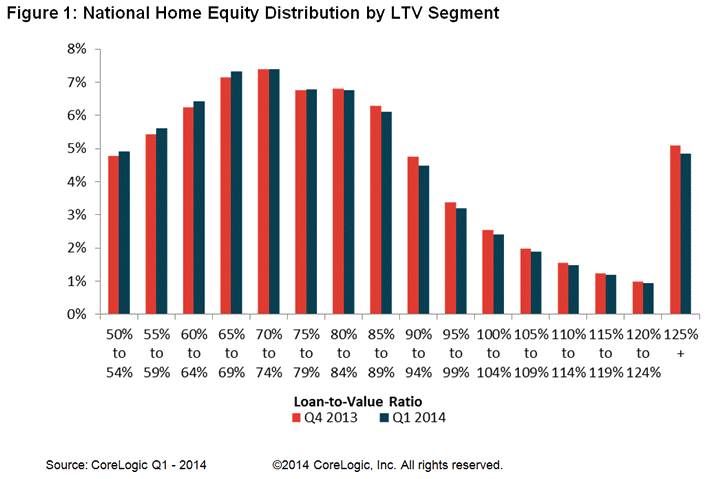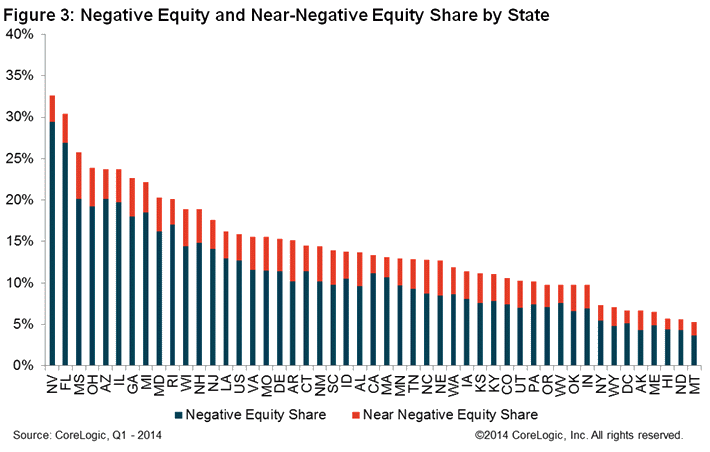U.S. homeowners continue to regain the equity in their homes which was lost in massive amounts during the housing crisis that began in 2007 and 2008. According to data released today by CoreLogic, more than 300,000 homes returned to a positive equity position in the first quarter of this year. This leaves approximately 6.3 million homes nationwide still "underwater" while more than 43 million mortgaged homes have some degree of equity.
Properties in negative equity represented 12.7 percent of homes with a mortgage at the end of the first quarter. At the end of the fourth quarter of 2013 where were 6.6 million or 13.4 percent of homes with a mortgage balance that exceeded the market value of the property and at the end of Q1 2013 there were 9.8 million homes or a 20.2 percent negative equity share.
"Prices continue to rise across most of the country and significantly fewer borrowers are underwater today compared to last year," said Anand Nallathambi, president and CEO of CoreLogic. "An additional rise in home prices of 5 percent, which we are projecting will occur over the next 12 months, will lift another 1.2 million properties out of the negative equity trap."
Nationally the aggregate negative equity totaled $383.7 billion at the end of Q1 2014. This was a decrease of $16.9 billion from approximately $400 billion in the fourth quarter 2013.
In addition to homes that are considered underwater, approximately 10 million more have less than 20 percent equity, more than 20.6 percent of all mortgage homes. These properties are considered by CoreLogic to be "under equitied" and their owners could have a difficult time refinancing or obtaining new financing a new home should they sell. More than 1.5 million of these under equitied homes have less than 5 percent equity and could sink back underwater should home prices fall.

"Despite the massive improvement in prices and reduction in negative equity over the last few years, many borrowers still lack sufficient equity to move and purchase a home," said Sam Khater, deputy chief economist for CoreLogic. "One in five borrowers have less than 10 percent equity in their property, which is not enough to cover the down payment and additional costs associated with a conventional mortgage."
The bulk of home equity for mortgaged properties is concentrated at the high end of the housing market. For example, 93 percent of homes valued at greater than $200,000 have equity compared with 82 percent of homes valued at less than $200,000.
Nevada continues to have the highest share of negative equity properties (29.4 percent) followed by Florida (26.9 percent), Mississippi (20.1 percent), Arizona (20.1 percent) and Illinois (19.7 percent). These top five states combined account for 31.1 percent of negative equity in the United States. The lowest percentages of negative equity are in Texas (3.3 percent), Montana (3.7 percent) North Dakota and Alaska (4.3 percent each), and Hawaii (4.4 percent).

Of the total $384 billion in negative equity, first liens without home equity loans accounted for $200 billion while homes with both loans accounted for $184 billion. The 3.8 billion borrowers with negative equity and no home equity loan owe an average of $218,000 on their mortgage and have negative equity of $52,000. The 2.5 million borrowers with both first and second liens have an average combined mortgage balance of $290,000 and are underwater by $75,000.
Lack of equity continues to be a strong indicator of mortgage default. Nationally, the number of homes with equity had a default rate of 0.6 percent in the first quarter, the same as in the previous quarter. However, homes with negative equity had a default rate of 3.5 percent as of Q1 2014, down from 3.7 percent in Q4 2013.







